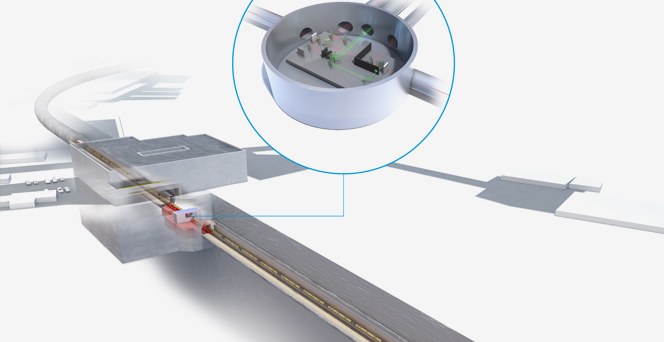URL: https://www.desy.de/e141261/e158573/e158729/index_eng.html
Breadcrumb Navigation

ALPS II
Light-through-the-wall experiment ALPS II
Researchers at DESY are not only interested in extremely heavy particles, which are being searched for with large high-energy accelerators. Hypothetical very light particles could also provide explanations for unexplained physical phenomena. Researchers at DESY are on the trail of these lightweights with the ALPS II experiment, which is downright tiny compared to the huge facilities at the LHC.
With large high-energy accelerators such as the Large Hadron Collider (LHC) at the CERN research centre near Geneva, physicists are searching for heavyweights – particles that may have eluded them so far because the energies reached by former accelerators were not sufficient to generate particles of such high mass. Some theories that take us beyond the Standard Model of particle physics predict the existence of new particles that are around 1000 times heavier than protons. However, recent theoretical work, along with some still poorly understood experimental observations, suggests that the “new physics” could also reveal itself through a host of extremely light particles.
These so-called WISPs (weakly interacting sub-eV particles) rarely react with matter and are therefore seldom generated, which means that their tracks would simply be drowned out by the flood of standard reactions in large high-energy accelerators. To detect these hypothetical WISPs at the lower end of the mass scale, researchers therefore need to use other means. These include the experiment ALPS (Any Light Particle Search) at DESY.
Light through a wall
The seemingly absurd proposal of the international team that runs the ALPS experiment is to make “light shine through a wall”. To achieve this, the researchers first direct a laser beam through the powerful magnetic field generated by decommissioned superconducting dipole magnets from the HERA ring accelerator. In the event that WISPs do actually exist, some of the photons (particles of light) in the laser beam should disappear and change into these mysterious lightweight particles. Installed in the middle between the magnets is a wall that stops the laser beam. The theory is that any WISPs produced would be able to pass through the wall – since they react so rarely with other particles, solid matter is no obstacle for them. Once they re-enter the magnetic field beyond the wall, the WISPs could then change back into particles of light, which would then show up in a photon detector. The light from the laser beam thus would have effectively passed through the wall.
Small but sharp
In the first phase of the ALPS experiment from 2007 to 2010, the physicists used a single HERA magnet. As the world’s most sensitive experiment in this field, ALPS provided the most precise limits on the existence of WISPs, improving previous results by a factor of 10. To further increase the sensitivity of the measurements by several orders of magnitude, ALPS II now searches for WISPs with 24 modified HERA dipoles, in the middle of which is the wall the particles are to pass through. Combined with so-called optical resonators on both sides of the wall and an extremely sensitive detection system that can detect one particle of light per day, ALPS II will be 12 orders of magnitude more sensitive than the first light-through-the-wall experiment at DESY. One goal of the team is to test astrophysical evidence for WISPs.
It may well turn out that ALPS II with its recycled HERA magnets will be quicker to deliver some long hoped-for signs of new physics than the experiments at the hugely expensive accelerator facilities. In any case, the hunt for extremely lightweight particles in the low-energy region ideally complements the large-scale experiments conducted at the highest energies. In combination, the results of each approach will make a vital contribution towards increasing our knowledge of the elementary building blocks of the universe and the way in which they interact with one another.
Research and development for ALPS II started in 2011. First results were presented in 2024.
More WISP experiments at DESY
If the WISP particles exist, they should also be produced in large amonts in the sun. The International AXion Observatory (IAXO) will search for WISPs emitted by the sun. In a dedicated magnet tracking the sun, such particles would convert to X-ray photons. BabyIAXO, the prototype for IAXO, will not only allow tests of crucial technologies, it will also reach unprecedented sensitivities in WISP searches. The construction of BabyIAXO at DESY could start in 2025, with first data from the experiment expected five years later.
The Magnetized Disk and Mirror Axion eXperiment (MADMAX) targets galactic axions, i.e. the dark matter that constantly surrounds us and ensures that our galaxy is held together. These ambient WISPs could convert to very feeble microwave radiation, again mediated by a strong magnetic dipole field. Prototype tests for MADMAX are currently ongoing; the final experiment might be finished in 2032.


